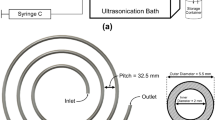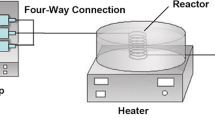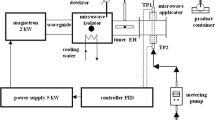Abstract
The combination of ultrasound and microreactors for the synthesis of nanomaterials is becoming increasingly popular, but effectively altering the ultrasonic field at the microscale to control the crystallization process remains a challenge. Herein, we investigated numerically and experimentally the effects of the ultrasonic field on the synthesis of boron-doped carbon nitride supported silver nanoparticles based on our homemade ultrasound-assisted coiled flow inverter microreactor (UCFIR). Specifically, the ultrasound promotes the radial mixing in the coiled flow inverter microreactor, even under low Reynolds number 10, resulting in better control over the crystallization process. The effects of key parameters, such as ultrasonic field distribution and ultrasonic power, on the particle size and size distribution of Ag/B-g-C3N4 have been demonstrated. The results show that when the ultrasound transducer is positioned on the ‘abc’ sides, the Ag/B-g-C3N4 with small and uniform Ag particles (4.12 ± 1.12 nm) can be obtained. As ultrasound power increased (0–176 W) and residence time decreased (17.5–140 s), the size of silver nanoparticles decreased, and their distribution narrowed.













Similar content being viewed by others
Data availability
The additional data that support the findings of this study are available from the corresponding author upon a reasonable request.
References
Qiao Z, Wang Z, Zhang C, Yuan S, Zhu Y, Wang J (2012) PVAm–PIP/PS composite membrane with high performance for CO2/N2 separation. AIChE J 59(4):215–228. https://doi.org/10.1002/aic
De Risi C, Bortolini O, Brandolese A, Di Carmine G, Ragno D, Massi A (2020) Recent advances in continuous-flow organocatalysis for process intensification. React Chem Eng 5(6):1017–1052. https://doi.org/10.1039/d0re00076k
Sebastian Cabeza V, Kuhn S, Kulkarni AA, Jensen KF (2012) Size-controlled flow synthesis of gold nanoparticles using a segmented flow microfluidic platform. Langmuir 28(17):7007–7013. https://doi.org/10.1021/la205131e
Wu KJ, De VarineBohan GM, Torrente-Murciano L (2017) Synthesis of narrow sized silver nanoparticles in the absence of capping ligands in helical microreactors. React. Chem. Eng. 2(2):116–128. https://doi.org/10.1039/c6re00202a
Marre S, Jensen KF (2010) Synthesis of micro and nanostructures in microfluidic systems. Chem Soc Rev 39(3):1183–1202. https://doi.org/10.1039/b821324k
Zhu H, Wu KJ, He CH (2021) Continuous Synthesis of Uniformly Dispersed Mesoporous SBA-15 Supported Silver Nanoparticles in a Coiled Flow Inverter Reactor. Front Chem 9(September):1–14. https://doi.org/10.3389/fchem.2021.747105
Ranadive P, Parulkar A, Brunelli NA (2019) Jet-mixing reactor for the production of monodisperse silver nanoparticles using a reduced amount of capping agent. React Chem Eng 4:1779–1789. https://doi.org/10.1039/c9re00152b
Luty-b M, Wojnicki M (2018) Green method for efficient PdNPs deposition on carbon carrier in the microreactor system. J Nanoparticle Res 20:239–254. https://doi.org/10.1007/s11051-018-4337-9
Besenhard MO, Pal S, Gkogkos G, Gavriilidis A (2023) Non-fouling flow reactors for nanomaterial synthesis. React Chem Eng 8:955–977. https://doi.org/10.1039/d2re00412g
Ding M, Cai X (2019) Improving MOF stability: approaches and applicaitons. Chem Sci 10:10209–10230. https://doi.org/10.1039/c9sc03916c
Zheng Z, Nguyen HL, Hanikel N, Li KK, Zhou Z, Yaghi OM (2023) High-yield, green and scalable methods for producing MOF-303 for water harvesting from desert air. Nat Protoc 18(January):18–23. https://doi.org/10.1038/s41596-022-00756-w
Ghosh A, Chowdhury B (2023) Synthesis of hollow mesoporous silica nanospheroids with O / W Emulsion and Al (III) incorporation and its catalytic. Catalysts 13(2):354–369. https://doi.org/10.3390/catal13020354
Jayan H, Sun D, Pu H, Wei Q (2023) Spectrochimica acta part A: molecular and biomolecular spectroscopy mesoporous silica coated core-shell nanoparticles substrate for size-selective SERS detection of chloramphenicol. Spectrochim. Acta Part A Mol. Biomol Spectrosc 284:121817–121826. https://doi.org/10.1016/j.saa.2022.121817
Kuang T et al (2023) Creating poly ( lactic acid )/ carbon nanotubes / carbon black nanocomposites with high electrical conductivity and good mechanical properties by constructing a segregated double network with a low content of hybrid nanofiller. Adv Compos Hybrid Mater 6(1):1–12. https://doi.org/10.1007/s42114-022-00622-z
Serp P, Castillejos E (2010) Catalysis in Carbon Nanotubes. ChemCatChem 2:41–47. https://doi.org/10.1002/cctc.200900283
Alosime EM (2023) A review on surface functionalization of carbon nanotubes : methods and applications. Discov Nano 18(1):1–11. https://doi.org/10.1186/s11671-023-03789-6
Shen Y et al (2020) Artificial trees for artificial photosynthesis: construction of dendrite-structured α‑Fe2O3/g‑C3N4 Z‑scheme system for efficient CO2 reduction into solar fuels. Appl Energy Mater 0–11. https://doi.org/10.1021/acsaem.0c00750.
Bhosale R, Jain S, Vinod CP, Kumar S, Ogale S (2019) Direct Z‑Scheme g‑C3N4/FeWO4 nanocomposite for enhanced and selective photocatalytic CO2 reduction under visible light. Appl Mater. Interfaces 2–11. https://doi.org/10.1021/acsami.8b22434
Zhang C et al (2022) Applied surface science construction of Z-scheme heterojunction CoS / CdS @ g-C3N4 hollow sphere with spatical charge separation for enhanced photocatalytic hydrogen production. Appl Surf Sci 626:157214–157224. https://doi.org/10.1016/j.apsusc.2023.157214
Liao G, Gong Y, Zhang L (2019) Environmental science semiconductor polymeric graphitic carbon nitride photocatalysts : the ‘“ holy grail ”’ for the photocatalytic hydrogen evolution reaction under visible light. Energy Environ Sci 12:2080–2147. https://doi.org/10.1039/c9ee00717b
Li K, Cai W, Zhang Z, Xie H, Zhong Q, Qu H (2022) Boron doped C3N5 for photocatalytic nitrogen fixation to ammonia: the key role of boron in nitrogen activation and mechanism. Chem Eng J 435(P2):135017–135029. https://doi.org/10.1016/j.cej.2022.135017
Zhou T et al (2022) Tailoring boron doped intramolecular donor–acceptor integrated carbon nitride skeleton with propelling photocatalytic activity and mechanism insight. Chem Eng J 445:136643–136656. https://doi.org/10.1016/j.cej.2022.136643
Iqbal W, Yang B, Zhao X, Mohamed IMA, Zhang J (2020) Facile one-pot synthesis of mesoporous g-C3N4 nanosheets with simultaneous iodine doping and N-vacancies for efficient visible-light-driven H2 evolution performance. Catal Sci Technol 549–559. https://doi.org/10.1039/c9cy02111f
Li W, Guo Z, Jiang L et al (2020) Facile in situ reductive synthesis of both nitrogen deficient and protonated g-C3N4 nanosheets for the synergistic enhancement of visible-light H2 evolution. Chem Sci 2716–2728. https://doi.org/10.1039/c9sc05060d
Lu L, Xu X, An K, Wang Y, Shi F (2018) Coordination polymer derived NiS@g‑C3N4 composite photocatalyst for sulfur vacancy and photothermal effect synergistic enhanced H2 production. Sustain Chem Eng 4–11. https://doi.org/10.1021/acssuschemeng.8b02153
Guo J et al (2019) An efficient carbon-based ORR catalyst from low-Temperature etching of ZIF-67 with ultra-small cobalt nanoparticles and high yield. J Mater Chem A 7(8):3544–3551. https://doi.org/10.1039/c8ta10925g
DelirKheyrollahiNezhad P, Haghighi M, Jodeiri N, Rahmani F (2016) Sol–gel preparation of NiO/ZrO2(x)–MgO(100–x) nanocatalyst used in CO2/O2 oxidative dehydrogenation of ethane to ethylene: influence of Mg/Zr ratio on catalytic performance. J Sol-Gel Sci Technol 80(2):436–450. https://doi.org/10.1007/s10971-016-4120-2
Arshad M et al (2019) Synthesis and characterization of SiO2 doped Fe2O3 nanoparticles: photocatalytic and antimicrobial activity evaluation. J Mol Struct 1180:244–250. https://doi.org/10.1016/j.molstruc.2018.11.104
Chen MX et al (2020) Identification of Catalytic Sites for Oxygen Reduction in Metal/Nitrogen-Doped Carbons with Encapsulated Metal Nanoparticles. Angew Chemie - Int Ed 59(4):1627–1633. https://doi.org/10.1002/anie.201912275
Zhang L et al (2017) Facile immobilization of Ag nanoparticles on microchannel walls in microreactors for catalytic applications. Chem Eng J 309:691–699. https://doi.org/10.1016/j.cej.2016.10.038
Zhang Q, Li N, Goebl J, Lu Z, Yin Y (2011) A systematic study of the synthesis of silver nanoplates: Is citrate a ‘magic’ reagent? J Am Chem Soc 133(46):18931–18939. https://doi.org/10.1021/ja2080345
Yang C et al (2011) Silver nanowires: From scalable synthesis to recyclable foldable electronics. Adv Mater 23(27):3052–3056. https://doi.org/10.1002/adma.201100530
Luo L, Yang M, Chen G (2020) Continuous Synthesis of Reduced Graphene Oxide-Supported Bimetallic NPs in Liquid-Liquid Segmented Flow. Ind Eng Chem Res 59(17):8456–8468. https://doi.org/10.1021/acs.iecr.0c00002
Xu J et al (2023) Nanoemulsification of soybean oil using ultrasonic microreactor: Process optimization, scale-up and numbering-up in series. Ultrason Sonochem 97:106451–106462. https://doi.org/10.1016/j.ultsonch.2023.106451
Zhao S, Yao C, Liu L, Yang M, Chen G (2023) Ultrasound emulsification in microreactors: effects of channel material, surfactant nature, and ultrasound parameters. Ind Eng Chem Res 62(12):5170–5180. https://doi.org/10.1021/acs.iecr.2c04645
Zhao S, Yao C, Dong Z, Chen G, Yuan Q (2020) Role of ultrasonic oscillation in chemical processes in microreactors: A mesoscale issue. Particuology 48:88–99. https://doi.org/10.1016/j.partic.2018.08.009
Ichikawa et al (2019) Microwave-mediated site-selective heating of spherical-carbon- bead-supported platinum for the continuous, efficient catalytic dehydrogenative aromatization of saturated cyclic hydrocarbons. Sustain Chem Eng 7:3052–3061. https://doi.org/10.1021/acssuschemeng.8b04655
Cong C, Nakayama S, Maenosono S, Harada M (2018) Microwave-assisted polyol synthesis of Pt/Pd and Pt/Rh bimetallic nanoparticles in polymer solutions prepared by batch and continuous-flow processing. Ind Eng Chem Res 57(1):179–190. https://doi.org/10.1021/acs.iecr.7b03154
Manno R, Sebastian V, Mallada R (2019) 110th anniversary: nucleation of ag nanoparticles in helical micro fluidic reactor. Comparison between microwave and conventional heating. Ind Eng Chem Res 58(28):12702–12711. https://doi.org/10.1021/acs.iecr.9b01460
Tsai SSH Kieda (2020) Magnetic polyelectrolyte microcapsules via water- in-water droplet microfluidics. Lab Chip 20:2851–2860. https://doi.org/10.1039/d0lc00387e
Descroix SS, Abou-hassan A (2015) Continuous chemical operations and modifications on magnetic c-Fe2O3 nanoparticles confined in nanoliter droplets for the assembly of fluorescent and magnetic SiO2@c-Fe2O3. Chem Commun 51:16904–16907. https://doi.org/10.1039/c5cc07044a
Li H et al (2004) Ultrasound-assisted polyol method for the preparation of SBA-15-supported ruthenium nanoparticles and the study of their catalytic activity on the partial oxidation of methane. Langmuir 20(19):8352–8356. https://doi.org/10.1021/la049290d
Satdeve NS, Ugwekar RP, Bhanvase BA (2019) Ultrasound assisted preparation and characterization of Ag supported on ZnO nanoparticles for visible light degradation of methylene blue dye. J Mol Liq 291:111313–111324. https://doi.org/10.1016/j.molliq.2019.111313
Stucchi M, Cerrato G, Bianchi CL (2019) Ultrasound to improve both synthesis and pollutants degradation based on metal nanoparticles supported on TiO2. Ultrason Sonochem 51:462–468. https://doi.org/10.1016/j.ultsonch.2018.07.011
Zhang R, Khalizov A, Wang L, Hu M, Xu W (2012) Nucleation and growth of nanoparticles in the atmosphere. Chem Rev 112(3):1957–2011. https://doi.org/10.1021/cr2001756
Miyasaka E, Kato Y, Hagisawa M, Hirasawa I (2006) Effect of ultrasonic irradiation on the number of acetylsalicylic acid crystals produced under the supersaturated condition and the ability of controlling the final crystal size via primary nucleation. J Cryst Growth 289(1):324–330. https://doi.org/10.1016/j.jcrysgro.2005.11.084
Kurotani M, Miyasaka E, Ebihara S, Hirasawa I (2009) Effect of ultrasonic irradiation on the behavior of primary nucleation of amino acids in supersaturated solutions. J Cryst Growth 311(9):2714–2721. https://doi.org/10.1016/j.jcrysgro.2009.03.009
Shi HH, Xiao Y, Ferguson S, Huang X, Wang N, Hao HX (2017) Progress of crystallization in microfluidic devices. Lab Chip 17(13):2167–2185. https://doi.org/10.1039/c6lc01225f
Fernandez Rivas D, Kuhn S (2016) Synergy of Microfluidics and Ultrasound: Process Intensification Challenges and Opportunities. Top. Curr. Chem 374(5):1–30. https://doi.org/10.1007/s41061-016-0070-y
Mao Y et al (2020) Enhancement of lysozyme crystallization under ultrasound field. Ultrason Sonochem 63:104975–104982. https://doi.org/10.1016/j.ultsonch.2020.104975
Hussain MN, Jordens J, John JJ, Braeken L, Van Gerven T (2019) Enhancing pharmaceutical crystallization in a flow crystallizer with ultrasound: anti-solvent crystallization. Ultrason Sonochem 59:104743–104753. https://doi.org/10.1016/j.ultsonch.2019.104743
Dalvi SV, Yadav MD (2015) Effect of ultrasound and stabilizers on nucleation kinetics of curcumin during liquid antisolvent precipitation. Ultrason Sonochem 24:114–122. https://doi.org/10.1016/j.ultsonch.2014.11.016
Beck C, Dalvi SV, Dave RN (2010) Controlled liquid antisolvent precipitation using a rapid mixing device. Chem Eng Sci 65(21):5669–5675. https://doi.org/10.1016/j.ces.2010.04.001
Dighe AV et al (2022) Autocatalysis and Oriented Attachment Direct the Synthesis of a Metal-Organic Framework. JACS Au 2(2):453–462. https://doi.org/10.1021/jacsau.1c00494
Shearer GC, Chavan S, Bordiga S, Svelle S, Olsbye U, Lillerud KP (2016) Defect Engineering: Tuning the Porosity and Composition of the Metal-Organic Framework UiO-66 via Modulated Synthesis. Chem Mater 28(11):3749–3761. https://doi.org/10.1021/acs.chemmater.6b00602
Butova VV, Zdravkova VR, Burachevskaia OA, Tereshchenko AA, Shestakova PS, Hadjiivanov KI (2023) In Situ FTIR Spectroscopy for Scanning Accessible Active Sites in Defect-Engineered UiO-66. Nanomaterials 13(10):1–16. https://doi.org/10.3390/nano13101675
Udepurkar AP, Clasen C, Kuhn S (2023) Emulsification mechanism in an ultrasonic microreactor: Influence of surface roughness and ultrasound frequency. Ultrason Sonochem 94:106323–106336. https://doi.org/10.1016/j.ultsonch.2023.106323
Pohl B, Jamshidi R, Brenner G, Peuker UA (2012) Experimental study of continuous ultrasonic reactors for mixing and precipitation of nanoparticles. Chem Eng Sci 69(1):365–372. https://doi.org/10.1016/j.ces.2011.10.058
Preeyanghaa M, Vinesh V, Sabarikirishwaran P, Rajkamal A, Ashokkumar M, Neppolian B (2022) Investigating the role of ultrasound in improving the photocatalytic ability of CQD decorated boron-doped g-C3N4 for tetracycline degradation and first-principles study of nitrogen-vacancy formation. Carbon N Y 192:405–417. https://doi.org/10.1016/j.carbon.2022.03.011
HaziMastan T, Lenka M, Sarkar D (2017) Nucleation kinetics from metastable zone widths for sonocrystallization of L-phenylalanine. Ultrason Sonochem 36:497–506. https://doi.org/10.1016/j.ultsonch.2016.12.017
Zhong X, Huang C, Chen L, Yang Q, Huang Y (2022) Effect of ultrasound on the kinetics of anti-solvent crystallization of sucrose. Ultrason Sonochem 82:105886–105896. https://doi.org/10.1016/j.ultsonch.2021.105886
Dong Z, Udepurkar A, Kuhn S (2020) Synergistic effects of the alternating application of low and high frequency ultrasound for particle synthesis in microreactors. Ultrason Sonochem 60(1):104800–104809. https://doi.org/10.1016/j.ultsonch.2019.104800
Zhu H, Wu KJ, He CH (2021) (2022) Ultrasound-assisted synthesis of visible-light-driven Ag/g-C3N4 catalysts in a continuous flow reactor. Chem Eng J 429:132412–132423. https://doi.org/10.1016/j.cej.2021.132412
Bampouli A et al (2023) Understanding the ultrasound field of high viscosity mixtures: experimental and numerical investigation of a lab scale batch reactor. Ultrason Sonochem 97:106444–106458. https://doi.org/10.1016/j.ultsonch.2023.106444
Zhang C, Okafor AN, Malik H, Nigam KDP, Nandakumar K (2022) Improved mass transfer performance of membrane units in a toroidal helical pipe—Reduction of concentration polarization by secondary flows. Chem Eng Process - Process Intensif 180:108759. https://doi.org/10.1016/j.cep.2021.108759
Toma M, Fukutomi S, Asakura Y, Koda S (2011) A calorimetric study of energy conversion efficiency of a sonochemical reactor at 500kHz for organic solvents. Ultrason Sonochem 18(1):197–208. https://doi.org/10.1016/j.ultsonch.2010.05.005
Wang X, Liu Z, Wang B, Cai Y, Song Q (2023) An overview on state-of-art of micromixer designs, characteristics and applications. Anal Chim Acta 1279:341685–341705. https://doi.org/10.1016/j.aca.2023.341685
Saikia D, Huang YY, Wu CE, Kao HM (2016) Size dependence of silver nanoparticles in carboxylic acid functionalized mesoporous silica SBA-15 for catalytic reduction of 4-nitrophenol. RSC Adv 6(42):35167–35176. https://doi.org/10.1039/c6ra01592a
Verma P, Kuwahara Y, Mori K, Yamashita H (2015) Synthesis and characterization of a Pd/Ag bimetallic nanocatalyst on SBA-15 mesoporous silica as a plasmonic catalyst. J Mater Chem A 3(37):18889–18897. https://doi.org/10.1039/c5ta04818d
Delacour C, Lutz C, Kuhn S (2019) Pulsed ultrasound for temperature control and clogging prevention in micro-reactors. Ultrason Sonochem 55(March):67–74. https://doi.org/10.1016/j.ultsonch.2019.03.012
Nalesso S, Bussemaker MJ, Sear RP, Hodnett M, Lee J (2019) A review on possible mechanisms of sonocrystallisation in solution. Ultrason Sonochem 57(February):125–138. https://doi.org/10.1016/j.ultsonch.2019.04.020
Sander JRG, Zeiger BW, Suslick KS (2014) Sonocrystallization and sonofragmentation. Ultrason Sonochem 21(6):1908–1915. https://doi.org/10.1016/j.ultsonch.2014.02.005
Liu Z, Yang M, Dong Z, Yao C, Chen G (2023) Cavitation behavior and mixing performance of antisolvent precipitation process in an ultrasonic micromixer. AIChE J 69:18080–18095. https://doi.org/10.1002/aic.18080
Acknowledgements
The authors are grateful for the financial support from the National Natural Science Foundation of China (Grant no. U22A20408), Zhejiang Provincial Key R&D Program (Grant no. 2022C01179) and Institute of Zhejiang University-Quzhou S&T Planed Projects (IZQ2021KJ2022 IZQ2022KJ1014) for this work.
Funding
National Natural Science Foundation of China,U22A20408, Zhejiang Provincial Key R&D Program, 2022C01179. Institute of Zhejiang University-Quzhou S&T Planed Projects (IZQ2021KJ2022 IZQ2022KJ1014).
Author information
Authors and Affiliations
Corresponding author
Additional information
Publisher's Note
Springer Nature remains neutral with regard to jurisdictional claims in published maps and institutional affiliations.
Supplementary Information
Below is the link to the electronic supplementary material.
Rights and permissions
Springer Nature or its licensor (e.g. a society or other partner) holds exclusive rights to this article under a publishing agreement with the author(s) or other rightsholder(s); author self-archiving of the accepted manuscript version of this article is solely governed by the terms of such publishing agreement and applicable law.
About this article
Cite this article
Tao, Yt., Wu, KJ. & He, CH. Continuous synthesis of boron-doped carbon nitride supported silver nanoparticles in an ultrasound-assisted coiled flow inverter microreactor. J Flow Chem 14, 177–196 (2024). https://doi.org/10.1007/s41981-023-00300-1
Received:
Accepted:
Published:
Issue Date:
DOI: https://doi.org/10.1007/s41981-023-00300-1




